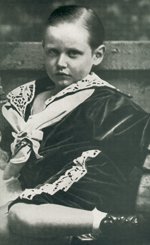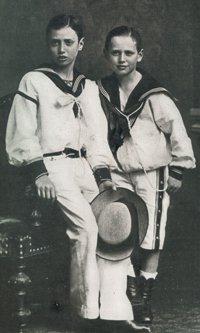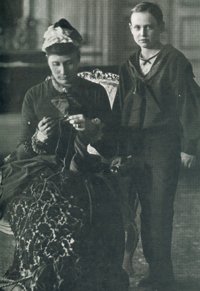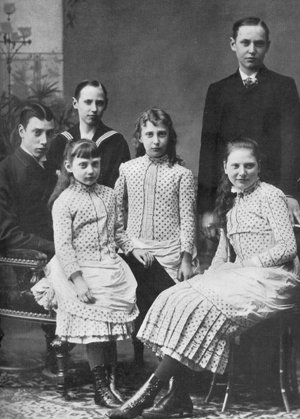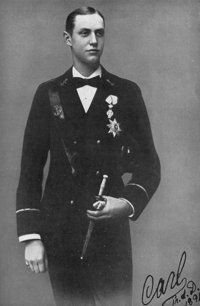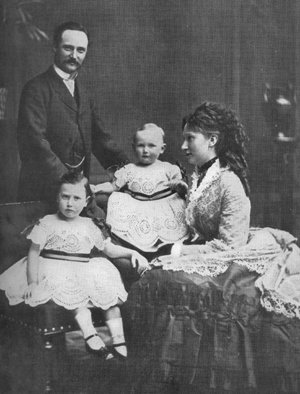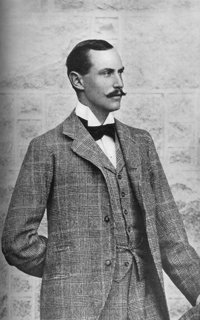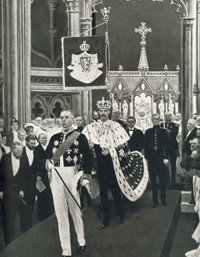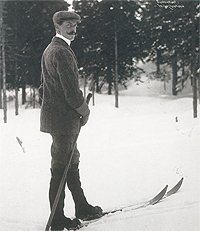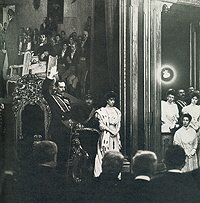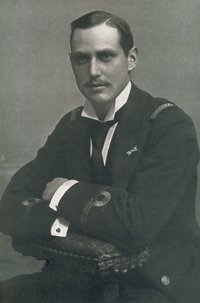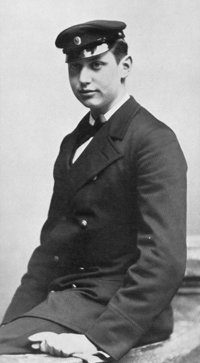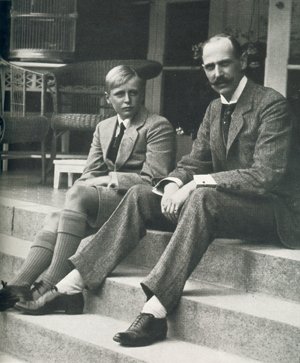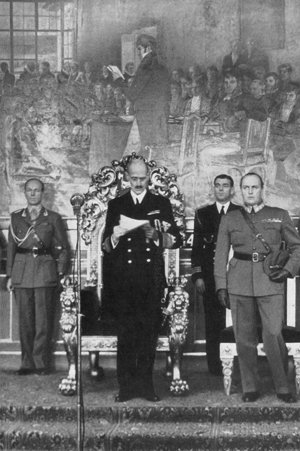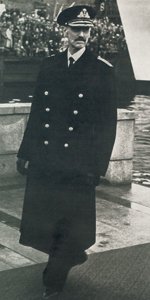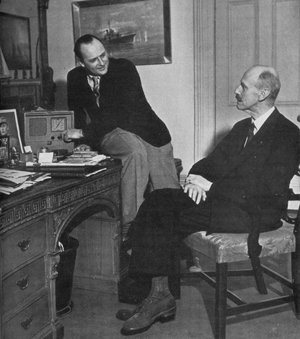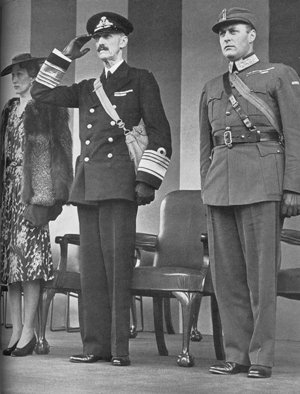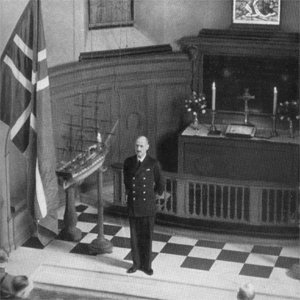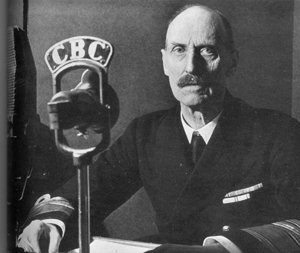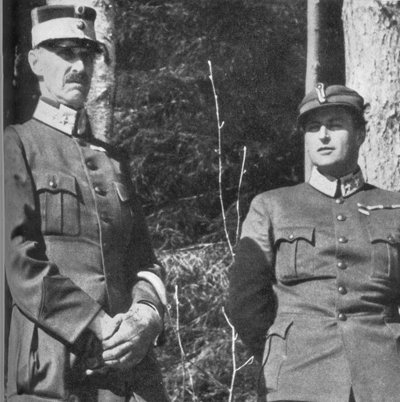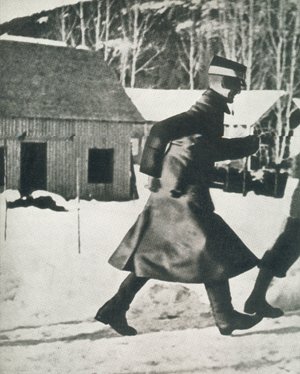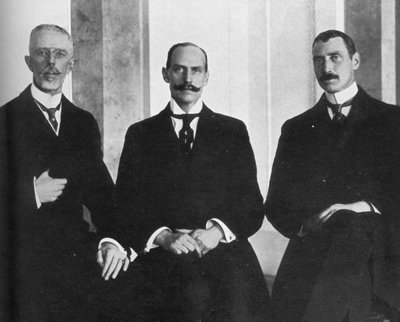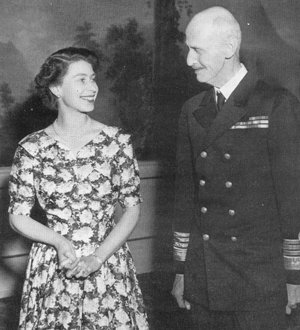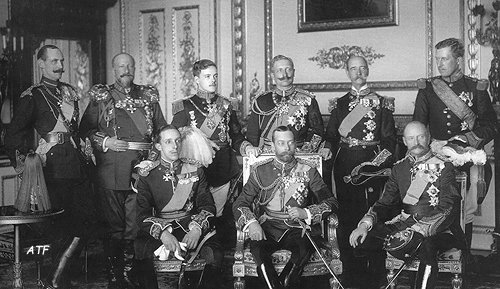norwegianne
Majesty
- Joined
- Nov 26, 2003
- Messages
- 6,041
- City
- Rogaland
- Country
- Norway
On August 4th, 1872, a bulletin was issued from Charlottenlund Castle in Denmark:
Yesterday at 4 o’clock Her Royal Highness the Crown Princess gave birth to a Prince. Both the Crown Princess and the new Prince had a good night.
A month later, the newly born prince of Denmark received the names Christian Frederik Carl Georg Valdemar Axel. He was named after both his grandfathers and his uncles, but since his two-year old brother was called Christian, he would be known as Carl.
Carl was the second son of the Crown Prince and Crown Princess of Denmark. He would have seven brothers and sisters: Christian, Louise, Harald, Ingeborg, Thyra, Gustav and Dagmar.
When his older brother Christian started school, Carl joined him. They had private lessons for every subject except gymnastics for which they joined the cadets at the Naval Academy.
Carl knew as a boy that he wanted to be a sailor and with his mother’s permission, he got an anchor tattoo. When he reached the age of fourteen, he joined one of the Danish Navy’s ships to start training for a naval career.
He worked as a volunteer trainee for a period of about nine months. As he showed potential, he was accepted at the Sea Officer School. The education lasted about six years, but Carl went through it, receiving the same treatment as his fellow students. He was however allowed to live at Amalienborg, while the others lived at the school.
Carl completed his training with the rank of second lieutenant in the Danish Navy. It was said that he, with his connections, should have been able to rise faster in the ranks than he did. However, neither the Crown Prince nor the King wanted him to have any preferential treatment, and Prince Carl stayed a second lieutenant for three years. In 1896 he was promoted to lieutenant.
Carl who had once refused a promotion to Captain, accepted the promotion that was offered in 1905. “I can’t offer the Norwegians a lieutenant as a King,” he remarked.
There are two incidents worth mentioning as a premonition of what would happen:
Carl remembered something from when he had been in the Mediterranean with the Navy in 1891. He had encountered an old woman in a booth. She had looked at him for a long time before she had declared, without knowing who he was, “You’re going to be king.” It was not a declaration that he liked at the time, because in order for that to happen his grandfather, father and older brother would have to die.
There was also a time when he was visiting the Norwegian town of Arendal in 1904. One of the town’s leading men hit him on the shoulder and said: “You should really be the king of Norway.” Two years later when he visited Arendal again, after being crowned in Trondheim, he met the man again. King Haakon lifted his glass and said: “Here’s to you, Smith. You were basically the first one to make me king of Norway.”
But we get ahead of ourselves.
One of Prince Carl’s friends has told that Carl used to have a photograph in his desk at school. When the teacher was busy somewhere else, Carl used to take the picture out to look at it. The picture was of his cousin:Maud of Wales.
Some years later, when Carl was 24, he married Princess Maud in the Chapel at Buckingham Palace. The couple settled in an apartment in Bredgade in Copenhagen. They also had a house in England, Appleton House on Sandringham estate.
After seven years of marriage the couple’s only child was born in 1903, Prince Alexander Edward Christian Frederik of Denmark. The family lived a quiet life in Copenhagen, and Prince Carl was still in the employ of the Danish Navy. That was all about to change, however, when the Norwegians set their sight on Carl as a possible candidate for the throne.
Further information on what happened in 1905 can be found here.
Carl was elected by the Norwegian people to be their first independent king since Olav IV inherited the throne of his Danish grandfather as well as his Norwegian father in the late 1300s.
Prince Carl decided that if he was to be king in Norway he had to study as much as he could beforehand. He began to read Norwegian history, studied the language, studied the classics, and he changed his name. Prince Christian Frederik Carl Georg Valdemar Axel of Denmark became King Haakon VII of Norway.
He was sworn into his office at Stortinget in Christiania the day after he arrived in the country, and the year after, in 1906, he was coronated in Nidarosdomen. He was the last of Norway’s king’s to be coronated.
King Haakon paid attention to his surroundings, and, in the 1920s gave Labour the task of forming the first Labour cabinet in Norway. The cabinet didn’t last very long, but the important thing, constitutionally, was that he had asked them. “I am also the king of the Republicans,” he was quoted saying.
When Queen Maud passed away in 1938, the King was devastated and so, he spent much time out at Skaugum with his grandchildren.
The German invasion of Norway in 1940 posed the severest threat to Carl’s reign. But as with many other difficulties, this weakened him for a short while. However, he profited by overcoming the difficulties and ended up in a stronger position as a result.
The Germans sent in a transport ship, Blücher, with dignitaries whose task it would be to capture the Royal Family and the Politicians so as to get a dominant position in Norway. Blücher was sunk by a cannon while on its way in the Oslofjord. Thanks to this, the Royal family, the Cabinet, most members of the parliament and the national gold deposit, got out of Oslo in time.
What followed was the Germans chasing the Norwegians northwards. The Royal family divided at Elverum, when Crown Princess Märtha took the three children, Ragnhild, Astrid and Harald, with her to her native Sweden. King Haakon and Crown Prince Olav followed along with the Cabinet over the mountains and to Molde.
During the escape they used code-names in any messages that went out. The King became known as the Boss, and the Crown Prince was his second in command. They quickly realized that they couldn’t stay in Molde as the town fell victim to the German bombardment, but they wanted to stay on Norwegian soil. A British ship solved their problem by transporting them to Tromsø. There, they celebrated the first May 17th even though not all of Norway was free.
Unfortunately after the German invasion of The Netherlands and Belgium it quickly became clear that the allied forces could no longer hold Norway. June 7th, nearly two months after the German invasion of April 9th, the King and his entourage left Norway. They wouldn’t return for another five years.
While in exile, the King worked tirelessly for Norway. Among other things he visited Norwegian schools, refugees, he made frequent speeches on the radio, both to Norway and to Great Britain. He also was an active participant in the military. The Norwegians fleet was ordered to England to assist the allied forces. A point of pride for the Norwegian Royal Family was that the Allies would never forget that Norway was amongst the nations fighting for peace.
In August 1942, King Haakon celebrated his 70th year anniversary in London. It was celebrated with a parade, and he was very pleased that his daughter-in-law had taken the trip over the Atlantic to celebrate the day with him.
The King returned to Norway June 7th, 1945, along with Crown Princess Märtha and the princesses Ragnhild and Astrid and Prince Harald on the British ship Norfolk.
He was met with scenes slightly similar to the ones that had met him when he had come to Norway 40 years earlier: people had gathered out in the streets in large masses to welcome him home.
King Haakon had cemented his place in Norway and Norwegian history, and for his 75th birthday celebrations, the Norwegian people collected money and presented him with a ship that became known as the royal ship, Norge.
In his younger years King Haakon had enjoyed cycling, skiing and walking, but as he grew older, he was forced to decrease many of his activities.
It was a great moment for him when in 1955 Queen Elizabeth II chose Norway and her Uncle Charles for her first state visit to a non-commonwealth country.
Unfortunately, a few days after the visit King Haakon slipped on his bathroom floor and broke his leg. He would never be the same again.
King Haakon died September 21st, 1957; he was 85 years old. He was laid to rest in the Royal tomb, where his wife and daughter-in-law had previously been laid to rest. King Haakon VII was succeeded by King Olav V.
Bibliography:
Dronning Maud – Et Portrett by Arvid Møller
Haakon VII, 1872-1947.
http://www.kongehuset.no
Yesterday at 4 o’clock Her Royal Highness the Crown Princess gave birth to a Prince. Both the Crown Princess and the new Prince had a good night.
A month later, the newly born prince of Denmark received the names Christian Frederik Carl Georg Valdemar Axel. He was named after both his grandfathers and his uncles, but since his two-year old brother was called Christian, he would be known as Carl.
Carl was the second son of the Crown Prince and Crown Princess of Denmark. He would have seven brothers and sisters: Christian, Louise, Harald, Ingeborg, Thyra, Gustav and Dagmar.
When his older brother Christian started school, Carl joined him. They had private lessons for every subject except gymnastics for which they joined the cadets at the Naval Academy.
Carl knew as a boy that he wanted to be a sailor and with his mother’s permission, he got an anchor tattoo. When he reached the age of fourteen, he joined one of the Danish Navy’s ships to start training for a naval career.
He worked as a volunteer trainee for a period of about nine months. As he showed potential, he was accepted at the Sea Officer School. The education lasted about six years, but Carl went through it, receiving the same treatment as his fellow students. He was however allowed to live at Amalienborg, while the others lived at the school.
Carl completed his training with the rank of second lieutenant in the Danish Navy. It was said that he, with his connections, should have been able to rise faster in the ranks than he did. However, neither the Crown Prince nor the King wanted him to have any preferential treatment, and Prince Carl stayed a second lieutenant for three years. In 1896 he was promoted to lieutenant.
Carl who had once refused a promotion to Captain, accepted the promotion that was offered in 1905. “I can’t offer the Norwegians a lieutenant as a King,” he remarked.
There are two incidents worth mentioning as a premonition of what would happen:
Carl remembered something from when he had been in the Mediterranean with the Navy in 1891. He had encountered an old woman in a booth. She had looked at him for a long time before she had declared, without knowing who he was, “You’re going to be king.” It was not a declaration that he liked at the time, because in order for that to happen his grandfather, father and older brother would have to die.
There was also a time when he was visiting the Norwegian town of Arendal in 1904. One of the town’s leading men hit him on the shoulder and said: “You should really be the king of Norway.” Two years later when he visited Arendal again, after being crowned in Trondheim, he met the man again. King Haakon lifted his glass and said: “Here’s to you, Smith. You were basically the first one to make me king of Norway.”
But we get ahead of ourselves.
One of Prince Carl’s friends has told that Carl used to have a photograph in his desk at school. When the teacher was busy somewhere else, Carl used to take the picture out to look at it. The picture was of his cousin:Maud of Wales.
Some years later, when Carl was 24, he married Princess Maud in the Chapel at Buckingham Palace. The couple settled in an apartment in Bredgade in Copenhagen. They also had a house in England, Appleton House on Sandringham estate.
After seven years of marriage the couple’s only child was born in 1903, Prince Alexander Edward Christian Frederik of Denmark. The family lived a quiet life in Copenhagen, and Prince Carl was still in the employ of the Danish Navy. That was all about to change, however, when the Norwegians set their sight on Carl as a possible candidate for the throne.
Further information on what happened in 1905 can be found here.
Carl was elected by the Norwegian people to be their first independent king since Olav IV inherited the throne of his Danish grandfather as well as his Norwegian father in the late 1300s.
Prince Carl decided that if he was to be king in Norway he had to study as much as he could beforehand. He began to read Norwegian history, studied the language, studied the classics, and he changed his name. Prince Christian Frederik Carl Georg Valdemar Axel of Denmark became King Haakon VII of Norway.
He was sworn into his office at Stortinget in Christiania the day after he arrived in the country, and the year after, in 1906, he was coronated in Nidarosdomen. He was the last of Norway’s king’s to be coronated.
King Haakon paid attention to his surroundings, and, in the 1920s gave Labour the task of forming the first Labour cabinet in Norway. The cabinet didn’t last very long, but the important thing, constitutionally, was that he had asked them. “I am also the king of the Republicans,” he was quoted saying.
When Queen Maud passed away in 1938, the King was devastated and so, he spent much time out at Skaugum with his grandchildren.
The German invasion of Norway in 1940 posed the severest threat to Carl’s reign. But as with many other difficulties, this weakened him for a short while. However, he profited by overcoming the difficulties and ended up in a stronger position as a result.
The Germans sent in a transport ship, Blücher, with dignitaries whose task it would be to capture the Royal Family and the Politicians so as to get a dominant position in Norway. Blücher was sunk by a cannon while on its way in the Oslofjord. Thanks to this, the Royal family, the Cabinet, most members of the parliament and the national gold deposit, got out of Oslo in time.
What followed was the Germans chasing the Norwegians northwards. The Royal family divided at Elverum, when Crown Princess Märtha took the three children, Ragnhild, Astrid and Harald, with her to her native Sweden. King Haakon and Crown Prince Olav followed along with the Cabinet over the mountains and to Molde.
During the escape they used code-names in any messages that went out. The King became known as the Boss, and the Crown Prince was his second in command. They quickly realized that they couldn’t stay in Molde as the town fell victim to the German bombardment, but they wanted to stay on Norwegian soil. A British ship solved their problem by transporting them to Tromsø. There, they celebrated the first May 17th even though not all of Norway was free.
Unfortunately after the German invasion of The Netherlands and Belgium it quickly became clear that the allied forces could no longer hold Norway. June 7th, nearly two months after the German invasion of April 9th, the King and his entourage left Norway. They wouldn’t return for another five years.
While in exile, the King worked tirelessly for Norway. Among other things he visited Norwegian schools, refugees, he made frequent speeches on the radio, both to Norway and to Great Britain. He also was an active participant in the military. The Norwegians fleet was ordered to England to assist the allied forces. A point of pride for the Norwegian Royal Family was that the Allies would never forget that Norway was amongst the nations fighting for peace.
In August 1942, King Haakon celebrated his 70th year anniversary in London. It was celebrated with a parade, and he was very pleased that his daughter-in-law had taken the trip over the Atlantic to celebrate the day with him.
The King returned to Norway June 7th, 1945, along with Crown Princess Märtha and the princesses Ragnhild and Astrid and Prince Harald on the British ship Norfolk.
He was met with scenes slightly similar to the ones that had met him when he had come to Norway 40 years earlier: people had gathered out in the streets in large masses to welcome him home.
King Haakon had cemented his place in Norway and Norwegian history, and for his 75th birthday celebrations, the Norwegian people collected money and presented him with a ship that became known as the royal ship, Norge.
In his younger years King Haakon had enjoyed cycling, skiing and walking, but as he grew older, he was forced to decrease many of his activities.
It was a great moment for him when in 1955 Queen Elizabeth II chose Norway and her Uncle Charles for her first state visit to a non-commonwealth country.
Unfortunately, a few days after the visit King Haakon slipped on his bathroom floor and broke his leg. He would never be the same again.
King Haakon died September 21st, 1957; he was 85 years old. He was laid to rest in the Royal tomb, where his wife and daughter-in-law had previously been laid to rest. King Haakon VII was succeeded by King Olav V.
Bibliography:
Dronning Maud – Et Portrett by Arvid Møller
Haakon VII, 1872-1947.
http://www.kongehuset.no
Last edited:


